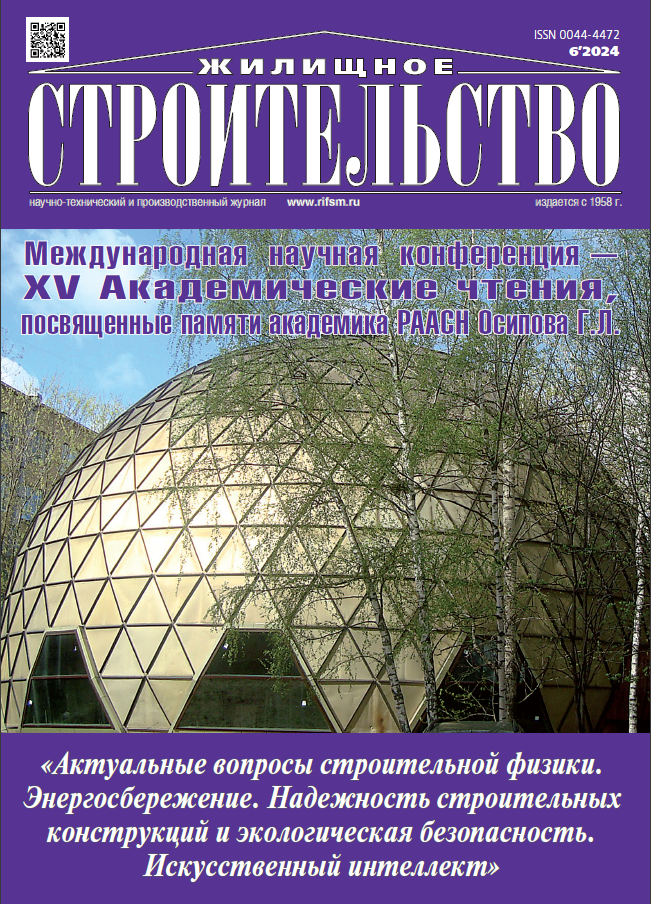О величине шага по азимуту ветрового потока при аэродинамических исследованиях высотных зданий
- Авторы: Пастушков П.П.1,2, Синявин А.А.1, Чулюнин А.Ю.1
-
Учреждения:
- МГУ им. М.В. Ломоносова
- Научно-исследовательский институт строительной физики РААСН
- Выпуск: № 6 (2024)
- Страницы: 49-52
- Раздел: СТАТЬИ
- URL: https://modernonco.orscience.ru/0044-4472/article/view/634825
- DOI: https://doi.org/10.31659/0044-4472-2024-6-49-52
- ID: 634825
Цитировать
Полный текст
Аннотация
В последние десятилетия в Российской Федерации активно развивается высотное строительство. Это привело к значительному увеличению аэродинамических исследований высотных объектов в соответствии с методикой СП 20.13330.2016 «СНиП 2.01.07–85* Нагрузки и воздействия». Во многих отечественных и зарубежных работах при проведении таких исследований шаг по углу азимута набегающего потока ветра составляет 15о (реже 20о). В настоящей работе представлены результаты, показывающие, что при таком шаге по азимуту ветра в условиях плотной разновысотной застройки происходит существенное занижение значений локальных отрицательных пиковых ветровых нагрузок. Обсуждается вопрос о достаточности шага по азимуту ветрового потока 5о.
Полный текст
Об авторах
П. П. Пастушков
МГУ им. М.В. Ломоносова; Научно-исследовательский институт строительной физики РААСН
Автор, ответственный за переписку.
Email: pavel-one@mail.ru
канд. техн. наук, Научно-исследовательский институт механики
Россия, 119192, г. Москва, Мичуринский пр-т, 1; 127238, г. Москва, Локомотивный пр., 21А. А. Синявин
МГУ им. М.В. Ломоносова
Email: sinjavinaa@yandex.ru
канд. физ.-мат. наук, Научно-исследовательский институт механики
Россия, 119192, г. Москва, Мичуринский пр-т, 1А. Ю. Чулюнин
МГУ им. М.В. Ломоносова
Email: chulyu-n@mail.ru
ст. науч. сотрудник, Научно-исследовательский институт механики
Россия, 119192, г. Москва, Мичуринский пр-т, 1Список литературы
- Poddaeva O., Fedosova A, Churin P, J. Gribach J. Conducting experimental investigations of wind influence on high-rise constructions. E3S Web of Conferences. 2018. Т. 33. DOI: https://doi.org/10.1051/e3sconf/20183302067
- Goryachevsky O. Numerical modelling of wind loads on windows. Validation for a high-rise square plan building. International Journal for Computational Civil and Structural Engineering. 2023. 19-3, pp. 114–129. DOI: https://doi.org/10.22337/2587-9618-2023-19-3-114-129
- Poddaeva O.I., Fedosova A.N., Gribach J.S. Experimental studies of wind impact on religious buildings. IOP Conference Series: Materials Science and Engineering, 2021. Vol. 31 (1). 012046. https://doi.org/10.1088/1757-899X/1015/1/012046
- Ke Y., Shen G., Yu H., Xie J. Effects of corner modification on the wind-induced responses of high-rise buildings. Applied Sciences. 2022. 12(19):9739. DOI: https://doi.org/10.3390/app12199739
- You H. Si C. Ma X., Shang J. Overall and local wind loads on post-installed elevator shaft of existing Buildings. Buildings. 2024. 14 (1):110. DOI: https://doi.org/10.3390/buildings14010110
- Flaga A., Kocon A., Kłaput R., Bosak G. The environmental effects of aerodynamic interference between two closely positioned irregular high buildings. Journal of Wind Engineering and Industrial Aerodynamics. 2018. 180, pp. 276–287. DOI: https://doi.org/10.1016/j.jweia.2018.07.024
- Гувернюк С.В., Гагарин В.Г. Компьютерное моделирование аэродинамических воздействий на элементы ограждений высотных зданий // АВОК. 2006. № 8. С. 18–24. Guvernyuk S.V., Gagarin V.G. Computer modeling of aerodynamic effects on elements of enclosures of high-rise buildings. AVOK. 2006. No. 8, pp. 18–24. (In Russian).
Дополнительные файлы













